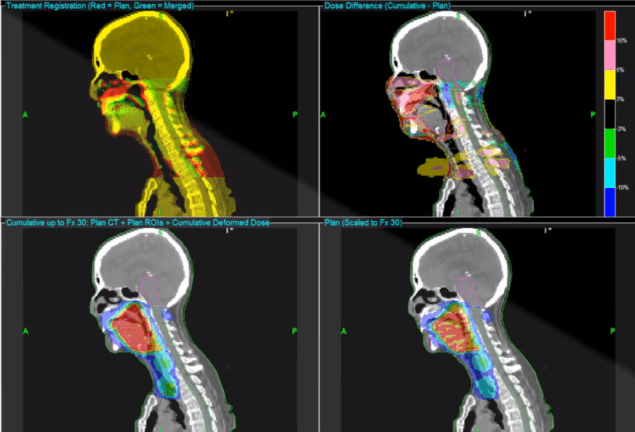
Intensity-modulated radiotherapy (IMRT) and variants such as volumetric-modulated arc therapy (VMAT) have proven to be game-changers in cancer treatment over the past decade, delivering precise and highly conformal “dose painting” of complex tumour sites while minimizing collateral damage to healthy tissue and nearby organs at risk. While the benefits are clear, the complexities of IMRT/VMAT treatment planning and delivery are such that a redoubled focus on all aspects of quality assurance (QA) is essential – not least in terms of patient-related QA to ensure that dose delivery remains within tolerance versus the original simulation and treatment plan.
Standard Imaging, a US-based provider of QA solutions for radiation oncology, believes that its Adaptivo patient dosimetry software ticks a lot of those patient QA boxes by providing a granular view into the daily and cumulative dose delivered as patient geometry, set-up and tumours change during the course of treatment. What’s more, the software automatically imports and analyses patients, presents data in a summary dashboard, and sends alerts for dose deviations that require attention from the oncologist.
Problem-solving
“The problem Adaptivo addresses is the gaping hole in treatment delivery in most radiation oncology clinics,” explains Shannon Holmes, staff medical physicist at Standard Imaging. “What’s missing is that day-to-day information to understand the impact of various geometric changes in the patient’s anatomy [e.g. weight loss, tumour shrinkage] or patient positioning on the overall quality of the treatment,” she adds. “Put simply, are we hitting the target and are we doing it in the way we intended in the treatment plan?”

To align with existing clinical workflows, Adaptivo’s functionality is organized into three core building blocks. The Pre-treatment module verifies IMRT and VMAT delivery using the treatment system’s portal imager, streamlining pre-treatment QA without the need for phantoms or additional detectors. The software communicates directly with the record and verify (R&V) system and automatically compares measured results to the predicted image (with email notification of either each pre-treatment delivery or only those that fail acceptance criteria).
The In Vivo module, meanwhile, provides daily exit-dose monitoring to identify unforeseen deviations from the treatment plan, performing portal-to-calculated and portal-to-portal comparisons of per-beam metrics, per-fraction metrics and gamma metrics. The software’s third module, Adaptive, provides daily and cumulative 3D dose analysis, automatically mapping the original planned contours to daily cone-beam CT images (or the most recent cone-beam image set). This deformable registration ensures that changes in tumour size and patient weight loss, for example, are factored into both daily and cumulative dose and dose volume histogram (DVH) tracking.
Clinical upside
So what are the main operational benefits of Adaptivo for medical physicists and the wider radiation oncology team? “I would say insight first and foremost,” notes Holmes, citing the access the software provides to daily information about patient set-up and anatomy variations and the impact on dose distributions. “Having the data to assess those patient changes gives confidence that you are delivering high-quality treatments,” she explains. “I guess there’s also the issue of having the hard data to support decision-making if you need to replan a patient – or whether, despite patient weight loss for example, your treatment plans are still robust.”
Workflow efficiencies also figure prominently, with Holmes noting that Adaptivo’s automated data input and analysis allows medical physicists to focus their time on tasks that align with their abilities and training. “With Adaptivo, a physicist would be analysing results rather than just transferring files and hitting ‘calculate’,” she explains. “The software also makes chart-checks more meaningful because you’re no longer just looking at whether the number of MU [monitor units] delivered matches the number of MU that were planned. You can actually understand the impact on your patient: was the dose distribution as expected, was the patient set-up in alignment, was the daily treatment in line with what was expected.”
Radiation oncologists can quickly judge whether a replan is needed, focusing on those plans that truly require altering and expediting the approval process
Shannon Holmes
It’s the insights that Adaptivo provides – highlighting daily and cumulative dose deviations or trends – that’s the big differentiator in terms of patient QA and enhanced treatment outcomes. Consider head-and-neck cancer, a clinical indication that commonly requires treatment replanning during a course of radiation therapy. “For head-and-neck patients,” explains Holmes, “it often hurts to eat during treatment, so the patient loses weight and there’s often significant anatomical change in a location that affects the attenuation of the treatment beam.”
Within Adaptivo, those anatomical changes manifest as higher exit doses in the In Vivo module, an indicator that attenuation is decreasing. In this scenario, the 3D dose calculations in the Adaptive module will display how the daily doses on the cone-beam CT are changing as the patient loses weight, mapping that daily data back onto the planning CT to give a cumulative delivered dose distribution.
In turn, says Holmes, “the Adaptive module will actually generate a predictive, cumulative dose flag that tells you, based on how you’ve been treating so far, whether you’re going to be outside the tolerance you’ve set yourself by the end of the treatment – and if so, how far out you’re going to be.”
Holmes concludes: “It’s this complete view of delivered dose that gives the data and confidence needed to validate any replanning. Radiation oncologists can quickly judge whether a replan is needed, focusing on those plans that truly require altering and expediting the approval process.”
Standard Imaging released Version 1.3 of Adaptivo earlier this summer and will be showcasing the latest features of the software at the ASTRO Annual Meeting this week. Version 1.3 enhancements include compatibility with ARIA version 15 (Varian’s R&V system) and pretreatment QA functionality for 10 MV beams. Disease-specific gamma criteria can now be applied for both the Pre-treatment and In Vivo analysis modules, while there’s also a representative beam data option for In Vivo commissioning.
- Standard Imaging will be exhibiting at booth 1435 during the ASTRO Annual Meeting in Chicago, IL, from 15-17 September.




